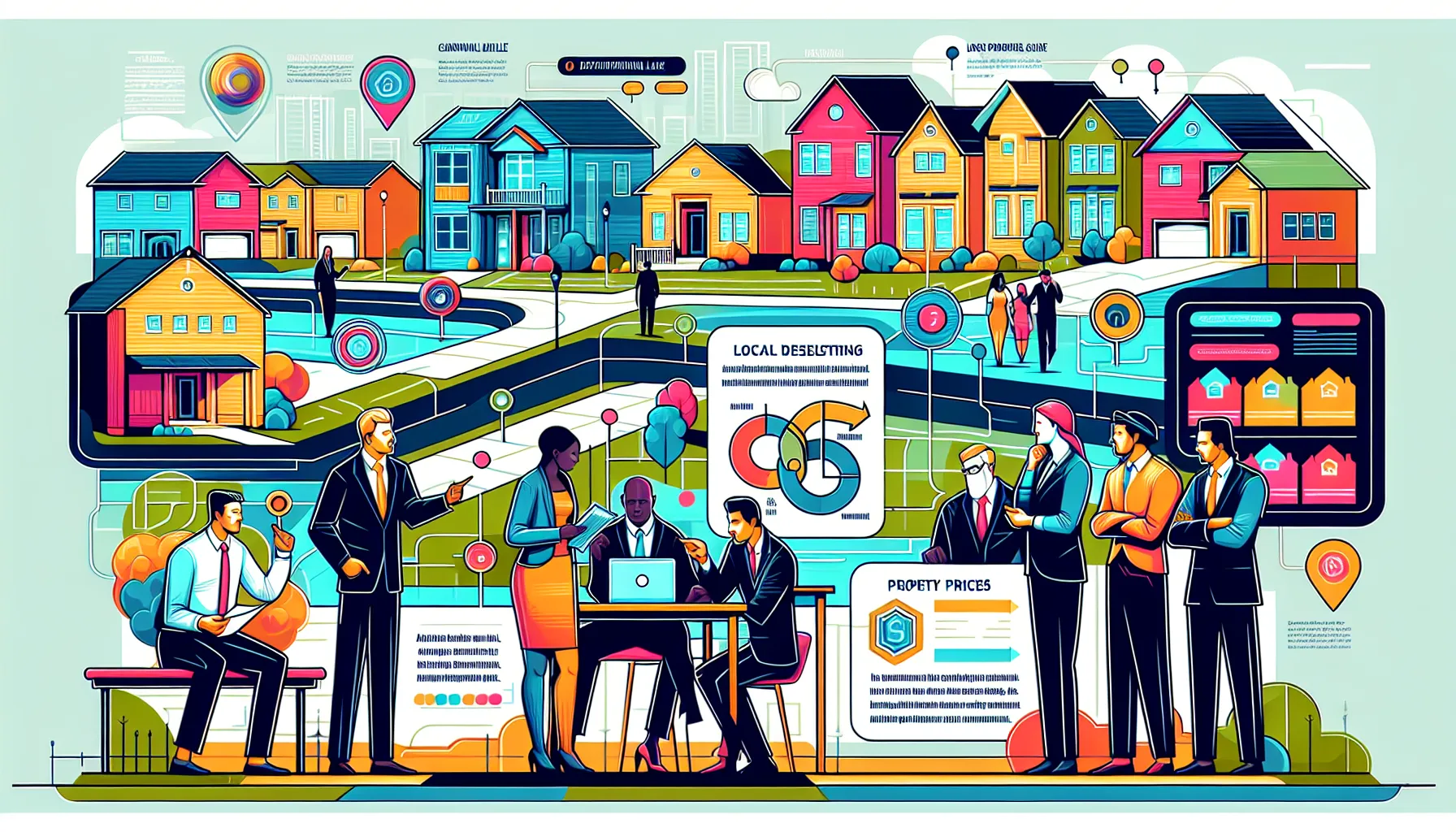Key Takeaways
- Danville property cost forecasting relies on analyzing recurring fees, maintenance expenses, and market trends to create accurate estimates for buyers and investors.
- Key factors influencing property costs include local economic trends, job market shifts, development projects, and supply-demand dynamics.
- Effective forecasting methods use historical data analysis and predictive modeling to anticipate costs like inspection fees, leasing charges, and management expenses.
- Current Danville market trends show rising home values, strong competition due to limited listings, and growing demand for energy-efficient or upgraded homes.
- Accurate cost forecasting helps buyers and investors plan for long-term financial decisions, avoid surprise expenses, and compare investment options confidently.
- Challenges include unexpected local policy changes, data gaps, market volatility, and unpredictable events that can impact property cost projections.
Thinking about the future of property costs in Danville can feel overwhelming. Prices seem to shift overnight and new fees or updates can pop up when you least expect them. Whether you’re planning to buy, sell, or simply want to understand your investment, having a clear idea of what shapes these costs is important.
Have you ever wondered what factors drive changes in property expenses? From inspection fees and maintenance costs to marketing charges and leasing fees, every dollar counts. I know how important it is to have reliable information before making big decisions. Let’s explore what you need to consider so you can feel confident about your next step in Danville’s property market.
Understanding Danville Property Cost Forecasting
Clear property cost forecasting in Danville means looking closely at factors like recurring fees, scheduled maintenance, and emerging expenses. I study average figures for services such as semi-annual inspections ($75 per visit), appraiser access ($125), and ongoing marketing costs ($150 for digital campaigns) to build an informed estimate. Maintenance fees and close-out charges, such as $100 per insurance claim or when closing a property, add to the mix.
I find that cost forecasting also involves doing more than just adding up numbers. It means paying attention to how improvements or new projects could change long-term costs, often at a rate of 7.5% of the project value. Are you weighing the impact of routine care against one-time investments? Many clients want to know how these choices play out over time and how they balance with their property goals.
Rental listing and leasing expenses, like a 2% listing fee or a $199 leasing fee, shape forecasts for owners of both single properties and portfolios. If, like many rental property owners in Danville, you manage properties from a distance, questions might come up about how these charges affect monthly returns or annual budgets.
Do you wonder which costs to prioritize for the best outcome? I analyze past data, track local market trends, and listen to client needs to help forecast property costs with as much clarity as possible. This way you gain a cleaner view of what’s ahead and can plan confidently for the future. What expenses or concerns do you want to explore further in Danville’s property landscape?
Key Factors Influencing Property Costs in Danville

Property costs in Danville change with shifts in local and broader forces. Have you wondered what truly shapes the value of homes here? I often hear this question, especially from those looking for clarity before making financial decisions.
Economic Trends and Job Market
Economic trends and a strong job market in Danville create steady demand for housing. Higher local employment rates make more people interested in buying homes, which can drive prices higher. During periods when layoffs or major business closures happen nearby, demand for homes shrinks and prices may drop. I always track changes in large employers, wage growth, and regional unemployment rates to create an accurate forecast. How do you see employment trends impacting your property plans?
Local Development and Infrastructure
New development, transit access, and updated public spaces directly influence Danville’s property values. Projects like new schools, retail centers, or improved roads often make an area more appealing and boost home prices. Plans for future construction or zoning changes also impact both short- and long-term costs. I keep an eye on city council meetings and published development plans because these updates hint at what’s likely coming next. What local improvements matter most to you when evaluating property?
Supply and Demand Dynamics
Supply and demand have the greatest effect on Danville property costs. Fewer available homes or higher buyer interest—like during a hot market—usually lead to price increases. If more properties hit the market or buyer interest dips, prices tend to stabilize or fall. Seasonal patterns, lending changes, and new listing volumes offer clues about what to expect over the next few months. Are you finding it harder to buy or sell in the current market?
Tools and Methods for Danville Property Cost Forecasting

Accurate forecasting of property costs in Danville depends on clear tools and reliable methods. I use strategies grounded in past trends and modern analytics to help you prepare for the future. Have you wondered which approaches offer the most reliable cost projections for your property decisions?
Historical Data Analysis
Historical data analysis helps forecast Danville property costs by examining records of fees and expenses from previous years. I track patterns for charges like leasing fees ($199), scheduled maintenance ($75), and management fees (6.5%–7.5% of monthly rent) over time. Comparing results across different rental amounts—from $10,001 to over $30,001 monthly—reveals how cost structures shift as rental volumes change.
Analysis highlights recurring expenses, such as appraiser access ($125) or marketing campaigns ($150), and quantifies their impact. When property values rise during periods of strong local demand, past reports make it easier to predict future spikes in inspection fees and related costs. Does looking at previous trends help you feel more prepared for potential price changes?
Predictive Modeling Techniques
Predictive modeling techniques use current data points and external market signals to estimate future property costs. I build cost models incorporating known inputs like insurance claim oversight ($100 per claim), improvement project percentages (7.5%), and market-specific factors such as supply and demand indicators.
Statistical models factor in known scheduled costs—annual maintenance, closing fees, and ad expenses—then adjust forecasts for variables like economic trends or rental growth. For example, if a property’s gross monthly total crosses $17,000, I apply the relevant management fee for a realistic projection. Scenario testing allows me to compare outcomes, asking, “How would a small shift in rental rates or unexpected repairs affect your budget?” Have you explored how scenario models might help you plan for uncertainties in Danville’s market?
Current Trends in Danville’s Real Estate Market

Current price movements show that median home values in Danville have climbed over 6% year-over-year, according to Zillow (2024). Inventory remains limited, which keeps listings competitive. Multiple-offer situations occur frequently, especially for three-bedroom homes near downtown or top-rated schools.
Rising demand links directly to population growth and increased remote work. Buyers are searching for flexible spaces, easy access to parks, and reliable internet. Have you noticed that renovated kitchens and energy-efficient upgrades boost home selling prices faster than standard updates? Modern buyers place real value on these enhancements.
Rental rates have also experienced steady growth, especially for single-family homes. Landlords are responding to frequent rental applications by raising deposits and screening qualifications. This trend increases costs for renters but provides investors with reliable cash flow opportunities.
Interest in ESG—environmental, social, and governance—features is gaining traction. More buyers inquire about solar panels, drought-resistant landscaping, and neighborhood walkability. Green-certified properties often attract attention faster and sell at premium prices.
Do you wonder how shifting mortgage rates affect your options? Rate changes in early 2024 caused a short dip in buyer activity, but strong local employment quickly restored stable demand. Sellers are encouraged by quick sales, while buyers explore adjustable-rate mortgages to maintain affordability.
Market analysts expect the pace of price growth to slow slightly if more listings arrive by late summer. Even so, low cancellation rates and consistent buyer demand indicate continued property market resilience in Danville.
Have you felt challenged by these rapid changes? If so, monitoring recent sale data and watching neighborhood trends help you anticipate price shifts more confidently.
How Buyers and Investors Can Use Property Cost Forecasting

Accurate property cost forecasting gives buyers and investors a clear picture of future expenses tied to properties in Danville. This means you can make thoughtful choices about when to buy, what kind of home fits your financial plan, and how to budget long term. Are you wondering how to spot new fees or avoid getting surprised by maintenance bills? Forecasting can help you anticipate costs like annual inspections ($75), home improvement expenses (7.5% of project cost), and leasing fees ($199), making financial planning more straightforward.
Investors benefit from tracking recurring fees and adjusting their strategies to maintain or grow rental yields. Taking monthly management fees or marketing charges into account—such as the 7% management fee for certain portfolios or a $150 digital marketing budget—helps you calculate accurate net returns. Do you want to compare the cash flow between single properties and multi-unit portfolios? Property cost estimates allow you to project outcomes side by side, factoring in itemized costs and potential rent variations.
Buyers use forecasting to assess ongoing affordability. For example, understanding liner costs like closeout and insurance claim fees ($100 per property or claim) helps you avoid surprises. This approach supports decisions about which neighborhoods or property types align with your budget and lifestyle goals. Curious about how rising demand or limited listings could impact your costs down the line? Monitoring trends and integrating them with expense forecasts lets you prepare for price shifts and adjust your buying plans confidently.
Openly reviewing itemized expense tables and local market data builds understanding and helps you feel prepared for each step. Have you considered how home improvements or new marketing approaches might change your bottom line? Applying forecasting tools puts you in control, whether you own one rental or an expanding portfolio, aiming for steady returns and sustainable growth in Danville’s competitive market.
Challenges and Limitations in Danville Property Cost Forecasting

Cost forecasting in Danville property markets involves several challenges that I face regularly. I pay close attention to shifting local policies, unexpected economic turns, and occasional data gaps. How do you handle changing city tax rates or new ordinance fees when planning long-term? Local governments sometimes introduce new charges or amend zoning rules with little warning, and that can disrupt even the most well-prepared estimates.
Data limitations often create uncertainty in my cost analysis. Publicly available transaction histories sometimes miss recent private sales or off-market deals. For example, I’ve seen estimates shift by over 10% when new sales data gets published for a single neighborhood. Are you relying on several sources to support your research, or do some gaps leave you with uncertain numbers?
Market volatility in Danville also disrupts trending patterns. Prices often react to broader economic signals such as sudden job growth or major employer relocation. If more buyers enter the market, costs for inspections and appraisals rise quickly—in some months, by as much as 18% year-over-year. Rental rates may change within just a few weeks, depending on listing demand or seasonal trends. Have you ever tried projecting maintenance costs, only to see local supplier rates jump unexpectedly?
Short supply of recent comparable property sales further complicates projections. If a neighborhood sees limited home turnover, older data skews median price and rental yield estimates. I frequently encounter situations where one high-priced sale or major renovation affects dozens of forecasts in the following quarter. Are you reviewing both new and older listings to find reliable price anchors?
Human factors introduce further limits. Damage from tenant misuse, overdue repairs, or missed maintenance can turn forecasts upside down. Natural events like severe weather suddenly increase service charges, repair costs, and insurance premiums. Has your budget ever shifted quickly after a storm or burst pipe?
I adjust my methods to reflect these unpredictabilities, combining fresh data, regular reviews, and cross-checks with neighborhood trends. Are you refining your approach as new information becomes available? By discussing these challenges, I help others develop stronger, more adaptable strategies for Danville’s property cost forecasting.
Conclusion
Navigating Danville’s property market takes a proactive mindset and a willingness to adapt as new trends emerge. I’ve found that staying alert to local developments and regularly reviewing market data can make all the difference when planning for future costs.
By using reliable forecasting tools and keeping an eye on both recurring and unexpected expenses I’m better equipped to make confident decisions. Whether you’re buying selling or investing ongoing education and flexibility will help you thrive in Danville’s ever-evolving property landscape.
Frequently Asked Questions
What are the main factors influencing property costs in Danville?
Property costs in Danville are influenced by local economic trends, job market stability, supply and demand dynamics, development projects, and infrastructure improvements like new schools or retail centers.
Why are property prices unpredictable in Danville?
Prices are unpredictable due to changing demand, shifting economic conditions, periodic new fees, and ongoing development in the area, all of which contribute to fluctuating property values.
How can buyers and investors forecast property costs in Danville?
Buyers and investors can use historical expense data, predictive modeling, and market trend analysis to estimate future costs and plan for recurring fees such as maintenance, inspections, and marketing.
Which recurring costs should property owners in Danville expect?
Common recurring costs include inspection and appraisal fees, routine maintenance, property management charges, leasing fees, and occasional marketing expenses for listing properties.
How do economic trends impact the Danville property market?
Rising employment and population growth can increase demand and drive prices higher, while layoffs or economic slowdowns may cause prices to stabilize or drop.
What are some emerging expenses in Danville’s property market?
Emerging expenses often include increased screening qualifications for tenants, higher rental deposits, energy-efficient upgrades, and costs linked to adding ESG features like solar panels.
How do development projects affect property values in Danville?
New schools, retail centers, and infrastructure improvements generally boost property values by making neighborhoods more attractive and increasing demand.
What tools help with accurate property cost forecasting?
Tools include historical data analysis, predictive modeling, and staying informed about local sale prices, rental rates, and neighborhood trends to anticipate cost changes.
How can investors optimize rental yields in Danville?
Investors should closely track recurring fees, maintenance costs, and local market shifts to adjust rental prices and investment strategies for optimal returns.
What challenges affect property cost forecasting in Danville?
Challenges include changing local regulations, unexpected economic shifts, market volatility, natural events, and data gaps that can impact the accuracy of forecasts.
